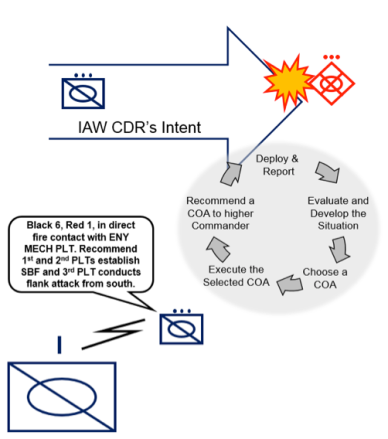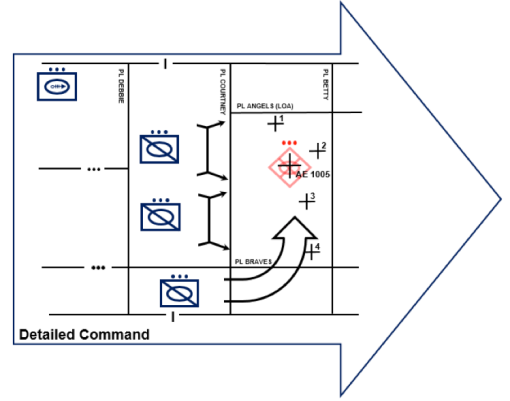By Alan Hastings
 Recent debate among military professionals on the subjects of mission command and detailed command has highlighted a common misunderstanding about each’s role in tactical operations. While we cannot expect to seize, retain, and exploit the initiative without embracing the philosophy of mission command, it is not a panacea to every tactical problem leaders are likely to face. Operations often require detailed command and control in order to achieve the overwhelming effects on the enemy necessary to accomplish the mission. Thus, both mission command and detailed command provide value to the tactical leader during operations.
Recent debate among military professionals on the subjects of mission command and detailed command has highlighted a common misunderstanding about each’s role in tactical operations. While we cannot expect to seize, retain, and exploit the initiative without embracing the philosophy of mission command, it is not a panacea to every tactical problem leaders are likely to face. Operations often require detailed command and control in order to achieve the overwhelming effects on the enemy necessary to accomplish the mission. Thus, both mission command and detailed command provide value to the tactical leader during operations.
The use of mission orders enables disciplined initiative by the tactical leader to pursue realization of the commander’s desired end state. The tactical leader conducts operations in accordance with his commander’s intent. When he encounters an enemy, he executes a decision cycle and acts in the manner that he believes will result in the most favorable outcome.
Against those enemies within his formation’s capabilities to defeat, he executes those maneuvers or battle drills that he and his formation have trained for just such a circumstance, defeats the enemy, and resumes the attack in accordance with the commander’s intent (Figure 1).

Figure 1 – The tactical leader executes a decision cycle (here, represented by actions on contact) and acts by conducting a well-rehearsed battle drill.
Against those enemies beyond his formation’s capabilities to defeat, he requests support from or provides recommendations to his higher commander for the employment of additional combat power (Figure 2).

Figure 2 – The tactical leader executes a decision cycle (again, represented by actions on contact) and acts by requesting support and making recommendations to the higher commander.
Up to this point, the higher commander’s mission orders and leadership via mission command have been adequate to solve all tactical problems that his subordinate leaders might face (Figure 3). The higher commander is able to conduct operations through decentralized execution based on mission orders. His subordinate leaders need little additional guidance beyond the commander’s intent.

Figure 3 – The higher commander conducts operations based on mission orders and decentralized execution.
However, once faced with a threat that his subordinate formations cannot defeat with their own organic capabilities, he must synchronize the maneuver of two or more of his subordinate formations and bring additional assets to bear in order to solve a more complex tactical problem. He too executes a decision cycle, observing (by receiving his subordinate’s report), orienting, deciding, and acting in the manner that he believes will result in the most favorable outcome. However, the synchronization of two or more assets requires detailed command, necessitating the use of common graphic control measures, well-defined triggers, and synchronized execution. Through detailed command and control, he defeats the enemy along his path of attack and resumes his mission (Figure 4). Similarly, if he finds that the enemy is beyond his combined capability to defeat, he may request support or provide recommendations to the next higher commander.

Figure 4 – The higher commander conducts operations, employing detailed control and synchronization of execution to achieve an overwhelming effect against the enemy.
Once this situation is resolved, he can then revert back to leading through mission orders and commander’s intent. By doing so, he allows subordinate leaders to act or make recommendations to seize emerging, yet fleeting opportunities on the battlefield, increasing the overall tempo of his operation.
In planning operations, commanders can predict those instances that will require synchronization of combat power and integration of multiple formations and assets. Often, this will prove to be either the main effort in a given phase of the operation or decisive point of the operation itself. In shaping operations and supporting efforts, we may accept risk and forgo detailed planning, confident in our subordinate formations’ abilities to accomplish the mission with their organic capabilities.
We should not approach mission command and detailed command with an either/ or mindset. Mission command and adherence to its principles allows the formation to retain its tempo through the identification of opportunities by and disciplined initiative of subordinate leaders. Without it, we stall out and become reactive, waiting on the commands of higher headquarters or the need to react to enemy actions. Yet detailed control allows us to overcome those complex tactical problems that require the full weight of combat power that we can bring to bear, synchronizing effects across all warfighting functions.
CPT Alan Hastings currently serves as a Senior Tactical Analyst at the National Training Center in Fort Irwin, California. He holds a B.S from the United States Military Academy. An armor officer, he has served as a Cavalry Troop OC/T, Troop Commander, and Tank Platoon Leader.
No comments:
Post a Comment